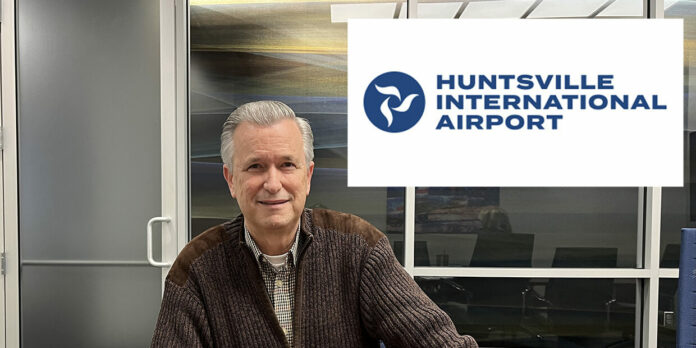HUNTSVILLE — As we drop the curtain on 2022, Huntsville International Airport will also say goodbye to Rick Tucker who is retiring as executive director after a nearly 45-year career.
While the reins have already passed to Executive Director Butch Roberts (256 Today will be talking to him next week), Tucker shared what he believes were the major milestones during his four decades at the airport.
“The biggest game-changer for the Port of Huntsville was getting a U.S. Customs Port of Entry in 1980,” said Tucker. “One of my first important jobs as chief accountant, who was also the only accountant at the airport back then, was helping fill out the application.”
Ed Mitchell, executive director of the airport in 1978 and the first chairman of the Airport Authority Board dating back to 1956, led the effort to put that together, working jointly with the Chamber of Commerce and the Industrial Development Association, which were separate entities.
“Ed was trying to implement the vision anticipated when the old airport was moved to its current location and the first master plan was in place,” said Tucker. “At the same time, he was laying the building blocks needed to accomplish the vision in a big way.”
The application sat dormant for two years with no action.
Then President Jimmy Carter’s campaign came to Huntsville and met with community leaders, asking, ‘What can we do for you?’
There is that U.S. Customs Port of Entry application…
“As soon as we got approval for the Customs Port of Entry, we filed an application to become a Foreign Trade Zone (No. 83), taking us international,” Tucker said. “With those two pieces in place, we began constructing the International Intermodal Center with speculative air cargo building space.
“It opened in 1986.”
Also in 1978, Carter signed the Airline Deregulation Act. So – rather than decades of the federal government through the Civil Aeronautics board regulating airfares, routes, and service – none of that time-consuming process was needed. It saved a month of time and people who had not been able to afford to fly before, were now able.
Meanwhile, significant industrial activity was happening simultaneously at the Jetplex Industrial Park.
Onan opened in 1971, followed by Chesebrough-Ponds in 1974. Lucky Gold Star, now LG Electronics, was the first Korean manufacturing firm in the United States.
“We convinced LG we could do it with the intermodal under construction and our new Foreign Trade Zone,” Tucker said. “But without all of that, they would not have located here.
“Without the Customs Port of Entry, we would never have extended our runways to accommodate cargo planes, and Sen. Richard Shelby would never have extended our west runway from 8,000 to 12,600 feet to accommodate Asian cargo service.”
Several other factors played into the rapid success of the airport under Tucker’s leadership.
“We had a priority to bring Boeing back to Huntsville in a big way – which happened in 1982-83.”
They built the parking deck in 1996-98 and began seeing traffic grow throughout the 1990s as the industrial base grew, along with Redstone consolidations.
There have been several remodels of the sections of the airport over the years, with more on the agenda.
From the cargo side, in 1990 Huntsville landed Panalpina, an international cargo and logistics company with direct cargo flights to Europe.
Then the state of Alabama began looking at a location for an international airport. The board expanded the master plan to show what was possible here in Huntsville.
The airport had 3,000 acres when it moved from south Huntsville. Since then, the airport has purchased more land.
“We are currently only utilizing one-third of the land capacity we have,” said Tucker. “They only needed 1,800 acres for the airport, and they set aside 1,200 acres for industrial development around the airport.
“We are set to expand into a full build-out of the future. That includes five parallel runways, the same as Atlanta Hartsfield today and, remember, HSV has a longer runway than Atlanta does.”
About Huntsville International, Tucker said, “We had a large airport in a small community at the time, but the community has grown with it.
“Now the airport is poised for the future.”
Don’t miss out! Subscribe to our email newsletter to have all our smart stories delivered to your inbox.



